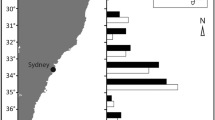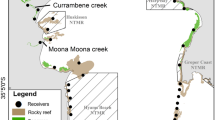Abstract
Effective marine habitat protection requires life history information, including identification of connected adult habitats and spawning sites, and movement information throughout those areas. Here, we implemented a mark-recapture study in the Bahamas Archipelago to estimate patterns of site fidelity, and to determine what homesites are connected to pre-spawning sites of economically important Bonefish (Albula vulpes) across multiple islands. We captured over 7000 Bonefish via seine netting, marked them with dart tags, and relied on fishing guides and anglers to report recaptures on Abaco, Grand Bahama, and Andros. Mark-recapture results from the three islands showed that 60–80% of Bonefish were recaptured within 5 km of their tagging site. Across the three islands, mean distance between mark and recapture was less than 11 km, suggesting space use that is tractable for effective marine reserve implementation. We also found that pre-spawning sites housed individuals from multiple homesites that were separated by distances up to 75 km. With these connections in mind, conserving Bonefish spawning biomass necessitates habitat protection in multiple home areas, along migratory corridors, and at pre-spawn and spawning locations. Our case study illustrates how mark-recapture of a C&R species can be used to identify habitats for protection. Information from this mark-recapture study contributed to the designation of six National Parks aimed at protecting habitats used by Bonefish, as well as other spatially overlapping species.





Similar content being viewed by others
References
Adams AJ (2017) Guidelines for evaluating the suitability of catch and release fisheries: lessons learned from Caribbean flats fisheries. Fish Res 186:672–680
Adams AJ, Murchie KJ (2015) Recreational fisheries as conservation tools for mangrove habitats.. In Murchie KJ, Daneshgar PP (eds) Mangroves as fish habitat. American fisheries society, symposium 83, Bethesda, Maryland, pp 43–56
Adams AJ, Wolfe RK, Tringali MD, Wallace E, Kellison GT (2008) Rethinking the status of Albula spp. biology in the Caribbean and Western Atlantic. In: Ault JS (ed) Biology and management of the World Tarpon and Bonefish Fisheries. CRC Press, Boca Raton
Adams AJ, Hill JE, Samoray C (2011) Characteristics of spawning ground fidelity by a diadromous fish: a multi-year perspective. Environ Biol Fish 92(3):403–411
Adams AJ, Shenker J, Jud Z, Lewis J, Danylchuk AJ (2018) Identifying pre-spawning aggregation sites for a recreationally important fish to inform conservation. Environ Biol Fish (in press)
Albanese B, Angermeier PL, Gowan C (2003) Designing mark–recapture studies to reduce effects of distance weighting on movement distance distributions of stream fishes. Trans Am Fish Soc 132(5):925–939
Black BD, Adams AJ, Bergh C (2015) Mapping of stakeholder activities and habitats to inform conservation planning for a national marine sanctuary. Environ Biol Fish 98(11):2213–2221
Bolden SK (2000) Long-distance movement of a Nassau grouper (Epinephelus striatus) to a spawning aggregation in the Central Bahamas. Fish Bull 98(3):642–645
Boucek RE, Rehage JS (2014) Climate extremes drive changes in functional community structure. Glob Chang Biol 20(6):1821–1831
Boucek RE, Heithaus MR, Santos R, Stevens P, Rehage JS (2017a) Can animal habitat use patterns influence their vulnerability to extreme climate events? An estuarine sportfish case study. Glob Chang Biol 23:4045–4057
Boucek R, Leone E, Walters-Burnsed S, Bickford J, Lowerre-Barbieri S (2017b) More than just a spawning location: examining fine scale space use of two estuarine fish species at a spawning aggregation site. Front Mar Sci 4:355
Cooke SJ, Cowx IG (2004) The role of recreational fishing in global fish crises. BioScience 54(9):857–859
Cooke SJ, Suski CD (2005) Do we need species-specific guidelines for catch-and-release recreational angling to effectively conserve diverse fishery resources? Biodivers Conserv 14(5):1195–1209
Cooke SJ, Danylchuk AJ, Danylchuk SE, Suski CD, Goldberg TL (2006) Is catch-and-release recreational angling compatible with no-take marine protected areas? Ocean Coast Manag 49(5):342–354
Cote J, Clobert J, Brodin T, Fogarty S, Sih A (2010) Personality-dependent dispersal: characterization, ontogeny and consequences for spatially structured populations. Philos Trans Royal Soc B 365(1560):4065–4076
Cunjak RA, Roussel JM, Gray MA, Dietrich JP, Cartwright DF, Munkittrick KR, Jardine TD (2005) Using stable isotope analysis with telemetry or mark-recapture data to identify fish movement and foraging. Oecologia 144(4):636–646
Danylchuk A, Danylchuk S, Philipp DP, Goldberg TL, Cooke SJ, Koppelman J (2007) Ecology and management of Bonefish (Albula spp.) in the Bahamian Archipelago. In: Ault J (ed) Biology and management of the World Tarpon and Bonefish Fisheries. CRC Press, Boca Raton
Danylchuk AJ, Cooke SJ, Goldberg TL, Suski CD, Murchie KJ, Danylchuk SE, Shultz AD, Haak CR, Brooks EJ, Oronti A, Koppelman JB (2011) Aggregations and offshore movements as indicators of spawning activity of bonefish (Albula vulpes) in the Bahamas. Mar Biol 158(9):1981–1999
Danylchuk AJ, Lewis J, Jud Z, Shenker J, Adams AJ (2018) Behavioral observations of bonefish during prespawning aggregations in the Bahamas: clues to drive broader conservation efforts. Environ Biol Fish (in press)
DeCelles GR, Martins D, Zemeckis DR, Cadrin SX (2017) Using fishermen’s ecological knowledge to map Atlantic cod spawning grounds on Georges Bank. ICES J Mar Sci 74(6):587–1601
Domeier ML, Speare P (2012) Dispersal of adult black Marlin (Istiompax indica) from a great barrier reef spawning aggregation. PLoS One 7(2):e31629. https://doi.org/10.1371/journal.pone.0031629
Farmer NA, Ault JS (2011) Grouper and snapper movements and habitat use in Dry Tortugas, Florida. Mar Ecol Prog Ser 433:169–184
Fedler T (2010) The economic impact of flats fishing in the Bahamas. The Bahamian Flats Fishing Alliance, pp 1–20. https://igmr.igfa.org/images/uploads/files/Bahamas_Flats_Economic_Impact_Report.pdf. Accessed 1/3/2018
Feeley MW, Morley D, Acosta A, Barbera P, Hunt J, Switzer T, Burton M (2018) Spawning migration movements of mutton snapper in Tortugas, Florida: spatial dynamics within a marine reserve network. Fish Res 204:209–223
Gaines SD, White C, Carr MH, Palumbi SR (2010) Designing marine reserve networks for both conservation and fisheries management. Proc Natl Acad Sci U S A 107(43):18286–18293
Green AL, Maypa AP, Almany GR, Rhodes KL, Weeks R, Abesamis RA, Gleason MG, Mumby PJ, White AT (2015) Larval dispersal and movement patterns of coral reef fishes, and implications for marine reserve network design. Biol Rev Camb Philos Soc 90:1215–1247
Grüss A, Kaplan DM, Guénette S, Roberts CM, Botsford LW (2011) Consequences of adult and juvenile movement for marine protected areas. Biol Conserv 144(2):692–702
Haak CR, Power M, Cowles G, Danylchuk A (2018) Hydrodynamic and isotopic niche differentiation between juveniles of two sympatric cryptic bonefishes, Albula vulpes and Albula goreensis in the Bahamas. Environ Biol Fish (in press)
Haley V (2009) Acoustic telemetry studies of bonefish (Albula vulpes) movement around Andros Island, Bahamas: implications for species management. FIU Electronic Theses and Dissertations, p 140
Halpern BS, Warner RR (2003) Matching marine reserve design to reserve objectives. Proc Royal Soc A 270(1527):1871–1878
Humston R, Ault JS, Larkin MF, Luo J (2005) Movements and site fidelity of the bonefish Albula vulpes in the northern Florida keys determined by acoustic telemetry. Mar Ecol Prog Ser 291:237–248
Johnson TR, van Densen WL (2007) Benefits and organization of cooperative research for fisheries management. ICES J Mar Sci 64(4):834–840
Kareiva PM (1983) Local movement in herbivorous insects: applying a passive diffusion model to mark-recapture field experiments. Oecologia 57(3):322–327
Kramer DL, Chapman MR (1999) Implications of fish home range size and relocation for marine reserve function. Environ Biol Fish 55(1–2):65–79
Larkin MF (2011) Assessment of south Florida’s bonefish stock. University of Miami (Doctoral dissertation, PhD Dissertation), p 194
Luckhurst BE (1998) Site fidelity and homing behaviour of tagged red hind (Epinephelus guttatus) to dawning aggregation sites at Bermuda. Proceedings of the 50th Gulf and Caribbean Fisheries Institute, pp 750–763
Mace GM, Harvey PH, Clutton-Brock TH (1983) Vertebrate home-range size and energetic requirements. In: Swingland IR, Greenwood PJ (eds) The ecology of animal movement. Clarendon Press, Oxford, pp 32–53
Moffitt EA, Botsford LW, Kaplan DM, O'Farrell MR (2009) Marine reserve networks for species that move within a home range. Ecol Appl 19(7):1835–1847
Murchie KJ, Cooke SJ, Danylchuk AJ, Danylchuk SE, Goldberg TL, Suski CD, Philipp DP (2013) Movement patterns of bonefish (Albula vulpes) in tidal creeks and coastal waters of Eleuthera, the Bahamas. Fish Res 147:404–412
Nichols JD, Pollock KH (1983) Estimation methodology in contemporary small mammal capture-recapture studies. J Mammal 64(2):253–260
NRC (National Research Council) (2004) Cooperative research in the National Marine Fisheries Service. National Academies Press, Washington, D.C.
Perez AU, Schmitter-Soto JJ, Adams AJ (2018) Connectivity mediated by seasonal bonefish (Albula vulpes) migration between the Caribbean Sea and a tropical estuary of Belize and Mexico. Environ Biol Fish, this issue
Powell RA (2000) Animal home ranges and territories and home range estimators. In: Research techniques in animal ecology: controversies and consequences, 1. Columbia University Press, New York, p 476
Roberge JM, Angelstam PER (2004) Usefulness of the umbrella species concept as a conservation tool. Conserv Biol 18(1):76–85
Roberts CM, Halpern B, Palumbi SR, Warner RR (2001) Designing marine reserve networks why small, isolated protected areas are not enough. Conservation 2(3):10–17
Sadovy De Mitcheson YS, Cornish A, Domeier M, Colin PL, Russell M, Lindeman KC (2008) A global baseline for spawning aggregations of reef fishes. Conserv Biol 22(5):1233–1244
Samoilys MA (1997) Movement in a large predatory fish: coral trout, Plectropomus leopardus (Pisces: Serranidae), on heron reef, Australia. Coral Reefs 16(3):151–158
Spiegel O, Leu ST, Bull CM, Sih A (2017) What's your move? Movement as a link between personality and spatial dynamics in animal populations. Ecol Lett 20(1):3–18
Switzer PV (1993) Site fidelity in predictable and unpredictable habitats. Evol Ecol 7(6):533–555
Wallace EM (2015) High intraspecific genetic connectivity in the indo-Pacific bonefishes: implications for conservation and management. Environ Biol Fish 98(11):2173–2186
Wallace EM, Tringali MD (2016) Fishery composition and evidence of population structure and hybridization in the Atlantic bonefish species complex (Albula spp.). Mar Biol 163(6):1–15
Weeks R, Green AL, Joseph E, Peterson N, Terk E (2017) Using reef fish movement to inform marine reserve design. J Appl Ecol 54(1):145–152
Acknowledgements
Funding provided by Bonefish & Tarpon Trust, Fisheries Conservation Foundation, Cape Eleuthera Institute. The non-profit institution Bonefish and Tarpon Trust conducted this study, and does not have a formal animal care and safety requirement for research. Despite this, all precautions were taken to ensure fishes survival. Thanks to the following for assistance with mark-recapture fieldwork: Abaco Lodge, Andros South, Bair’s Lodge, Deep Water Cay, H2O Bonefishing, North Riding Point, Black Fly Lodge, Abaco Fly Fishing Guides Association members.
Author information
Authors and Affiliations
Corresponding author
Electronic supplementary material
ESM 1
(DOCX 70 kb)
Rights and permissions
About this article
Cite this article
Boucek, R.E., Lewis, J.P., Stewart, B.D. et al. Measuring site fidelity and homesite-to-pre-spawning site connectivity of bonefish (Albula vulpes): using mark-recapture to inform habitat conservation. Environ Biol Fish 102, 185–195 (2019). https://doi.org/10.1007/s10641-018-0827-y
Received:
Accepted:
Published:
Issue Date:
DOI: https://doi.org/10.1007/s10641-018-0827-y




